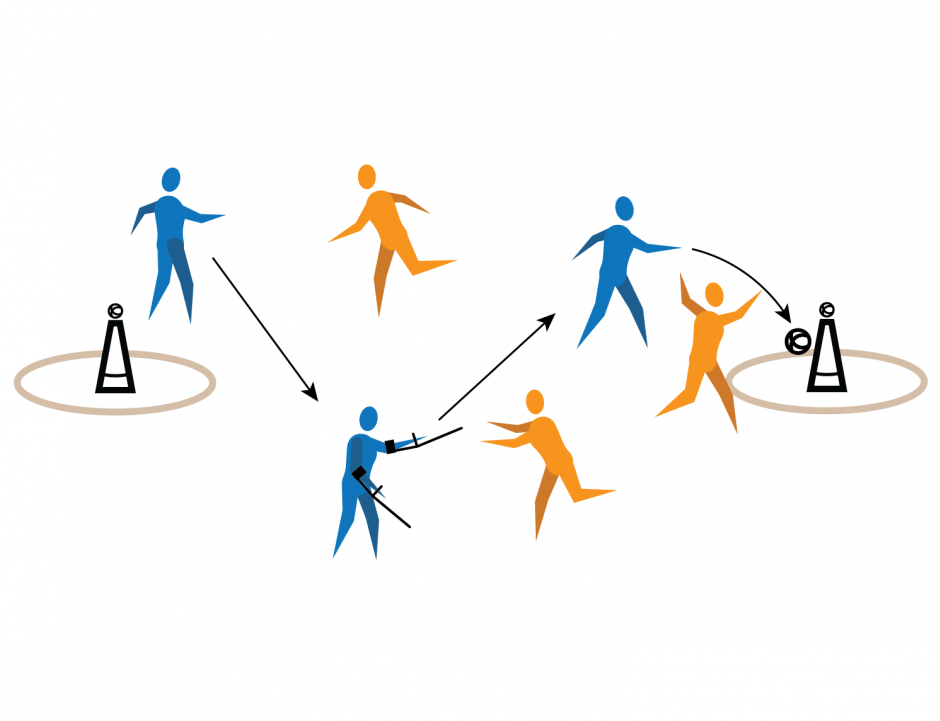TGfU Category: Zone Games
Locations: gymnasium, multipurpose room, outdoor space (e.g., field, tarmac)
Game/Sport Connections
Zone games are activities that involve controlling an object, keeping it away from opponents, and moving it into position to score. Both offensive and defensive players share the same playing area as they work to prevent the other team from scoring. By playing these games, participants develop skills and tactics to play other zone games or games that require the application of similar skills, concepts, and strategies (e.g., soccer, handball, ultimate Frisbee, football, basketball, hockey, goalball, wheelchair basketball, lacrosse).
Activity Overview
Participants learn about and practise working as a group to move into another group’s space and knock down their target.
Key Movement Skills, Concepts, and Strategies
Throughout the activity, consider highlighting the following skills, concepts, and strategies as participants work as a group to move into another group’s space and knock down their target. Note that this list is not exhaustive and further learning opportunities may arise during the task.
Movement Skills and Concepts
Manipulation skills and effort awareness: applying a controlled force to send/receive objects to/from another participant and/or to a target (e.g., making short and quick passes to move a ball quickly into an opposing group’s space).
Movement Strategies
Creating and applying tactics in order to move into another group’s space and to defend your space (e.g., using offensive tactics by passing the object to group members who have moved into open space, away from defenders and toward a target where possible)
Considerations
- Incorporate some or all of the variations listed in the “Variations” section while planning the activity. This will help to best meet the diverse backgrounds, identities, needs, and interests of participants and maximize the fun, inclusion, participation, and success of everyone.
- To elevate participant voice and choice, periodically pause the activity and share the variations with participants. Ask them to determine how they would like to change the activity to maximize the fun, inclusion, meaningful participation, and success for everyone. Encourage participants to add any variations of their own.
Equipment
- 1 object to send per game (e.g., different sizes and textures of ball, disc, rubber chicken)
- 1 pinnie per participant
- 2 balls per game
- 2 hula hoops per game
- 2 pylons per game
Safety
- Inspect the equipment and activity area to identify and remove hazards. Check that the activity surface provides sufficient traction.
- Establish the boundaries for the designated playing area at a safe distance from walls and obstacles. Share the boundaries with participants.
- Review the safety rules and activity instructions with participants prior to the activity.
- Instruct participants to be aware of their surroundings, including the locations of other participants during play.
How to Play
- Divide participants into small groups (e.g., 4 – 6). Use pinnies to identify groups.
- Two groups play in each designated playing area.
- Groups place a hula hoop (the “crease”) at each end of their playing area.
- Groups place a pylon with a ball on top in each hoop. This is their target.
- Groups decide the object to send (e.g., different sizes and textures of ball, disc, rubber chicken) and how to send it to knock over their opponent's target (e.g., underhand or overhand throw, non-dominant hand/foot, kicking while maintaining contact with the ground). Groups may change their object and how they send it at any point during play.
- The game begins with a round of Rock, Paper, Scissors, with the winner gaining possession of the object.
- The group with the object works together to pass the object to hit the opposing group’s target. To score a point, the target must fall to the ground.
- A participant with the object cannot move and must try to pass the object to a participant in their group or attempt to score on their opponent’s target.
- The other group works together to intercept passes without using body contact.
- Participants without the object try to move into open space to receive a pass.
- When a target is hit, it is placed back on top of the pylon. Play resumes with the opposing group taking possession of the object.
- After a period of play, provide participants with some or all of the variations. Ask them to decide how they might change the game to enhance the fun, inclusion, and participation for everyone. Encourage participants to add any variations of their own.
- Consider having groups share their variations and select another variation to try with their group.
Image: Visual Depiction of the Activity Instructions

Pause for Learning
Throughout the activity, ask open-ended questions to help participants refine their movement skills, strategies, and tactical solutions. Examples include:
- When on offense, what do you do to make sure you are ready to receive a pass?
- When on defense, where do you position yourself so that you have a higher chance of intercepting the ball?
- How does communication play a role on the offensive and defensive groups?
- Which games or sports have you played or know about that use similar rules and strategies to the ones used in this game?
Variations
- Increase or decrease the size of the playing area.
- Create a larger crease around the target (e.g., use tape on the ground).
- Add more targets and objects to the game to allow more participation.
- Increase the number of targets and groups playing within a game (e.g., have 4 targets on each end of the playing area and 4 groups playing. Groups have the choice of moving into any of the other group’s space, attempting to knock down their target.


